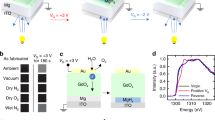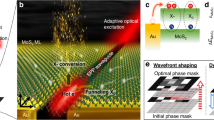Abstract
Dephasing and non-radiative decay processes limit the performance of a wide variety of quantum devices at room temperature. Here we illustrate a general pathway to notably reduce the detrimental impact of these undesired effects through photonic design of the device electrodes. Our design facilitates a large Purcell enhancement that speeds up competing, desired radiative decay while also enabling convenient electrical gating and charge injection functions. We demonstrate the concept with a free-space optical modulator based on an atomically thin semiconductor. By engineering the plasmonic response of a nanopatterned silver gate pad, we successfully enhance the radiative decay rate of excitons in a tungsten disulfide monolayer by one order of magnitude to create record-high modulation efficiencies for this class of materials at room temperature. We experimentally observe a 10% reflectance change as well as 3 dB signal modulation, corresponding to a 20-fold enhancement compared with modulation using a suspended monolayer in vacuum. We also illustrate how dynamic control of light fields can be achieved with designer surface patterns. This research highlights the benefits of applying radiative decay engineering as a powerful tool in creating high-performance devices that complements substantial efforts to improve the quality of materials.
This is a preview of subscription content, access via your institution
Access options
Access Nature and 54 other Nature Portfolio journals
Get Nature+, our best-value online-access subscription
$29.99 / 30 days
cancel any time
Subscribe to this journal
Receive 12 print issues and online access
$209.00 per year
only $17.42 per issue
Buy this article
- Purchase on Springer Link
- Instant access to full article PDF
Prices may be subject to local taxes which are calculated during checkout




Similar content being viewed by others
Data availability
All key data that support the findings of this study are included in the article and its Supplementary Information. Further datasets and raw measurements are available from the corresponding author on reasonable request.
References
Mak, K. F., Lee, C., Hone, J., Shan, J. & Heinz, T. F. Atomically thin MoS2: a new direct-gap semiconductor. Phys. Rev. Lett. 105, 136805 (2010).
Splendiani, A. et al. Emerging photoluminescence in monolayer MoS2. Nano Lett. 10, 1271–1275 (2010).
Lien, D.-H. et al. Electrical suppression of all nonradiative recombination pathways in monolayer semiconductors. Science 364, 468–471 (2019).
Radisavljevic, B. & Kis, A. Mobility engineering and a metal–insulator transition in monolayer MoS2. Nat. Mater. 12, 815–820 (2013).
Das, S. et al. Transistors based on two-dimensional materials for future integrated circuits. Nat. Electron. 4, 786–799 (2021).
Wu, S. et al. Monolayer semiconductor nanocavity lasers with ultralow thresholds. Nature 520, 69–72 (2015).
Ye, Y. et al. Monolayer excitonic laser. Nat. Photon. 9, 733–737 (2015).
Wilson, N. P., Yao, W., Shan, J. & Xu, X. Excitons and emergent quantum phenomena in stacked 2D semiconductors. Nature 599, 383–392 (2021).
Chernikov, A. et al. Electrical tuning of exciton binding energies in monolayer WS2. Phys. Rev. Lett. 115, 126802 (2015).
Jauregui, L. A. et al. Electrical control of interlayer exciton dynamics in atomically thin heterostructures. Science 366, 870–875 (2019).
Raja, A. et al. Coulomb engineering of the bandgap and excitons in two-dimensional materials. Nat. Commun. 8, 15251 (2017).
Castellanos-Gomez, A. et al. Local strain engineering in atomically thin MoS2. Nano Lett. 13, 5361–5366 (2013).
Li, Y. et al. Measurement of the optical dielectric function of monolayer transition-metal dichalcogenides: MoS2, MoSe2, WS2, and WSe2. Phys. Rev. B 90, 205422 (2014).
Chernikov, A. et al. Exciton binding energy and nonhydrogenic Rydberg series in monolayer WS2. Phys. Rev. Lett. 113, 076802 (2014).
Yu, Y. et al. Giant gating tunability of optical refractive index in transition metal dichalcogenide monolayers. Nano Lett. 17, 3613–3618 (2017).
Datta, I. et al. Low-loss composite photonic platform based on 2D semiconductor monolayers. Nat. Photon. 14, 256–262 (2020).
van de Groep, J. et al. Exciton resonance tuning of an atomically thin lens. Nat. Photon. 14, 426–430 (2020).
Biswas, S., Grajower, M. Y., Watanabe, K., Taniguchi, T. & Atwater, H. A. Broadband electro-optic polarization conversion with atomically thin black phosphorus. Science 374, 448–453 (2021).
Willner, A. E. et al. Optical communications using orbital angular momentum beams. Adv. Opt. Photon. 7, 66–106 (2015).
Schwarz, B. Mapping the world in 3D. Nat. Photon. 4, 429–430 (2010).
Silva, A. et al. Performing mathematical operations with metamaterials. Science 343, 160–163 (2014).
Lin, X. et al. All-optical machine learning using diffractive deep neural networks. Science 361, 1004–1008 (2018).
Liu, M. et al. A graphene-based broadband optical modulator. Nature 474, 64–67 (2011).
Xu, Q., Schmidt, B., Pradhan, S. & Lipson, M. Micrometre-scale silicon electro-optic modulator. Nature 435, 325–327 (2005).
Back, P., Zeytinoglu, S., Ijaz, A., Kroner, M. & Imamoğlu, A. Realization of an electrically tunable narrow-bandwidth atomically thin mirror using monolayer MoSe2. Phys. Rev. Lett. 120, 037401 (2018).
Scuri, G. et al. Large excitonic reflectivity of monolayer MoSe2 encapsulated in hexagonal boron nitride. Phys. Rev. Lett. 120, 037402 (2018).
Li, M., Biswas, S., Hail, C. U. & Atwater, H. A. Refractive index modulation in monolayer molybdenum diselenide. Nano Lett. 21, 7602–7608 (2021).
Epstein, I. et al. Near-unity light absorption in a monolayer WS2 Van der Waals heterostructure cavity. Nano Lett. 20, 3545–3552 (2020).
Selig, M. et al. Excitonic linewidth and coherence lifetime in monolayer transition metal dichalcogenides. Nat. Commun. 7, 13279 (2016).
Sönnichsen, C. et al. Drastic reduction of plasmon damping in gold nanorods. Phys. Rev. Lett. 88, 077402 (2002).
Dahmen, C., Schmidt, B. & von Plessen, G. Radiation damping in metal nanoparticle pairs. Nano Lett. 7, 318–322 (2007).
Lamprecht, B. et al. Metal nanoparticle gratings: influence of dipolar particle interaction on the plasmon resonance. Phys. Rev. Lett. 84, 4721–4724 (2000).
Bogdanov, S. I., Boltasseva, A. & Shalaev, V. M. Overcoming quantum decoherence with plasmonics. Science 364, 532–533 (2019).
Grange, T. et al. Reducing phonon-induced decoherence in solid-state single-photon sources with cavity quantum electrodynamics. Phys. Rev. Lett. 118, 253602 (2017).
Horng, J. et al. Engineering radiative coupling of excitons in 2D semiconductors. Optica 6, 1443–1448 (2019).
Purcell, E. M. Spontaneous emission probabliities at radio frequencies. Phys. Rev. 69, 681 (1946).
Hooper, I. R. & Sambles, J. R. Dispersion of surface plasmon polaritons on short-pitch metal gratings. Phys. Rev. B 65, 1–9 (2002).
Chen, P. et al. Approaching the intrinsic exciton physics limit in two-dimensional semiconductor diodes. Nature 599, 404–410 (2021).
Fan, S., Suh, W. & Joannopoulos, J. D. Temporal coupled-mode theory for the Fano resonance in optical resonators. J. Opt. Soc. Am. A 20, 569 (2003).
Chaves, A. et al. Bandgap engineering of two-dimensional semiconductor materials. npj 2D Mater. Appl. 4, 29 (2020).
Liu, F. et al. Disassembling 2D van der Waals crystals into macroscopic monolayers and reassembling into artificial lattices. Science 367, 903–906 (2020).
Mak, K. F. et al. Tightly bound trions in monolayer MoS2. Nat. Mater. 12, 207–211 (2013).
Daus, A. et al. High-performance flexible nanoscale transistors based on transition metal dichalcogenides. Nat. Electron. 4, 495–501 (2021).
McClellan, C. J., Yalon, E., Smithe, K. K. H., Suryavanshi, S. V. & Pop, E. High current density in monolayer MoS2 doped by AlOx. ACS Nano 15, 1587–1596 (2021).
McDonnell, S. et al. HfO2 on MoS2 by atomic layer deposition: adsorption mechanisms and thickness scalability. ACS Nano 7, 10354–10361 (2013).
Morozov, S., Wolff, C. & Mortensen, N. A. Room‐temperature low‐voltage control of excitonic emission in transition metal dichalcogenide monolayers. Adv. Opt. Mater. 9, 2101305 (2021).
Allain, A., Kang, J., Banerjee, K. & Kis, A. Electrical contacts to two-dimensional semiconductors. Nat. Mater. 14, 1195–1205 (2015).
Andersen, T. I. et al. Beam steering at the nanosecond time scale with an atomically thin reflector. Nat. Commun. 13, 3431 (2022).
Park, J., Kang, J.-H., Kim, S. J., Liu, X. & Brongersma, M. L. Dynamic reflection phase and polarization control in metasurfaces. Nano Lett. 17, 407–413 (2017).
van de Groep, J., Li, Q., Song, J.-H., Kik, P. G. & Brongersma, M. L. Impact of substrates and quantum effects on exciton line shapes of 2D semiconductors at room temperature. Nanophotonics https://doi.org/10.1515/nanoph-2023-0193 (2023).
Acknowledgements
We would like to acknowledge funding from an AFOSR MURI grant (grant no. FA9550-17-1-0002) and the US Department of Energy (grant no. DE-FG07-ER46426).
Author information
Authors and Affiliations
Contributions
Q.L. and M.L.B. conceived the research idea. Q.L. built the model, performed the design and fabrication of optical modulators with input from J.v.d.G. Q.L., J.-H.S. and F.X. performed the experimental characterization of the optical modulators. A.C.J. and F.L. prepared monolayer WS2 samples. J.H. performed wire-bonding for electrical characterization. A.D. and E.P. helped with atomic layer deposition. Y.J.L. helped with photoluminescence measurement. M.L.B. supervised the project. All of the authors contributed to writing the manuscript.
Corresponding author
Ethics declarations
Competing interests
The authors declare no competing interests.
Peer review
Peer review information
Nature Photonics thanks Alex Krasnok and Zongfu Yu for their contribution to the peer review of this work.
Additional information
Publisher’s note Springer Nature remains neutral with regard to jurisdictional claims in published maps and institutional affiliations.
Supplementary information
Supplementary Information
Supplementary Notes 1–3 and Figs. 1–19.
Rights and permissions
Springer Nature or its licensor (e.g. a society or other partner) holds exclusive rights to this article under a publishing agreement with the author(s) or other rightsholder(s); author self-archiving of the accepted manuscript version of this article is solely governed by the terms of such publishing agreement and applicable law.
About this article
Cite this article
Li, Q., Song, JH., Xu, F. et al. A Purcell-enabled monolayer semiconductor free-space optical modulator. Nat. Photon. 17, 897–903 (2023). https://doi.org/10.1038/s41566-023-01250-9
Received:
Accepted:
Published:
Issue Date:
DOI: https://doi.org/10.1038/s41566-023-01250-9
This article is cited by
-
Dynamical control of nanoscale light-matter interactions in low-dimensional quantum materials
Light: Science & Applications (2024)
-
Excitonic devices based on two-dimensional transition metal dichalcogenides van der Waals heterostructures
Frontiers of Chemical Science and Engineering (2024)



